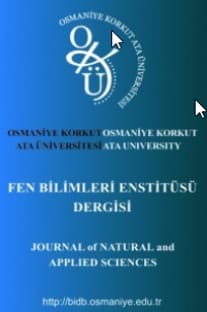Çok Kriterli Karar Verme Teknikleri ile Kurumsal Kaynak Planlama Sistemi Seçimi
Enterprise Resource Planning System Selection with Multi-Criteria Decision Making Techniques
___
- [1] Erdem HK. Kurumsal kaynak planlama sistemlerinin kullanımında etkili olan faktörlerin genişletilmiş teknoloji kabul modeli ile incelenmesi, Doktora Tezi, İstanbul Teknik Üniversitesi Fen Bilimleri Enstitütüsü 243; İstanbul, Türkiye, 2011.
- [2] Chang M., Cheung W., Cheng C., Yeung J. Understanding ERP system adoption from the user’s perspective, International. Journal of Production Economics 2008; 113(2): 928-942. doi: 10.1016/j.ijpe.2007.08.011.
- [3] Vatansever K., Uluköy M. Kurumsal kaynak planlaması sistemlerinin bulanık AHP ve bulanık MOORA yöntemleriyle seçimi: üretim sektöründe bir uygulama, Manisa Celal Bayar Üniversitesi Soyal Bilimler Dergisi 2013; 11(2): 274-293. doi: 10.18026/cbusos.34812.
- [4] Wei CC., Chien CF., Wang MJJ. An AHPbased approach to ERP system selection, International Journal of Production Economics 2005; 96(1): 47-62. doi: 10.1016/j.ijpe.2004.03.004.
- [5] Kumar K., Hillegersberg JV. ERP experiences and evolution, Communications of the ACM 2000; 43(4): 22-28. doi: 10.1145/332051.332063.
- [6] Rashid M., Hossain L., Patrick J. The evolution of ERP systems: A historical perspective, Enterprise Resource Planning: Solutions and Management, 2002; Fiona Fui-Hoon Nah (Missouri University of Science and Technology, USA): 35-50. doi: 10.4018/978-1-931777- 06-3.
- [7] Weilling K., Wei KK. Organizational culture and leadership in ERP implementation, Decision Support Systems, 2008; 45(2): 208-218. doi: 10.1016/j.dss.2007.02.002.
- [8] Gattiker TF., Goodhue DL. What happens after ERP implementation: Understanding the impact of interdependence and differentiation on plant-level outcomes, MIS Quarterly 2005; 29(3): 559-585. doi: 10.2307/25148695.
- [9] Teltumbde A. A framework for evaluating ERP projects, International Journal of Production Reserach 2000; 38(17): 4507- 4520. doi: 10.1080/00207540050205262.
- [10] Haddara M., Elragal A. The readiness of erp systems for the factory of the future, Procedia Computer Science 2015; 64(4) : 720-728. doi: 10.1016/j.procs.2015.08.598.
- [11] Aşan H., Ayçin E. Kurumsal kaynak planlama sistemlerinin seçimindeki kriterlerin Best-Worst metodu ile değerlendirilmesi, Bitlis Eren Üniversitesi İktisadi ve İdari Bilimler Fakültesi Akademik İzdüşüm Dergisi 2020; 5(2): 114-124.
- [12] Soh C., Kien SS., Tay-Yap J. Cultural fits and misfits: Is ERP a universal solution?, Communications of the ACM 2000; 43 (4): 47-56. doi: 10.1145/332051.332070.
- [13] Genoulaz BV., Millet PA., Grabot B. A survey on the recent research literature on ERP systems, Computers in Industry 2005 56(6): 510-522.
- [14] Gallego MD., Luna P., Bueno S . User acceptance model of open source software, Computers in Human Behavior 2008; 24 (5): 2199 -2216.
- [15] Rodrigue JP ., Notteboom T. The cold chain and its logistics, The Geography of Transport Systems, 5th edition, NY: Routledge; 2020.
- [16] Bueno S., Salmeron JL. TAM -based success modeling in ERP, Interacting with Computers 2008; 20(6): 515 -523. doi: 10.1016/j.intcom.2008.08.003.
- [17] Sarker S., Lee AS. Using a case study to test the role of three key social enablers in ERP implementation, Information Management 2003; 40(8): 813 -829 . doi: 10.1016/S0378 -7206(02)00103 -9.
- [18] Pekdoğan S. Karar verme stilleri araştırmaları: 2009 -2013 yılları arasındaki yüksek lisans tezlerinin incelenmesi, The Journal of Academic Social Science Studies, 2015; 34(2): 321 -331 . doi: 10.9761/jasss2788.
- [19] Acer A., Kalender S. Antrepoların performansının Entropi ve TOPSİS yöntemleriyle değerlendirilmesi, Dumlupınar Üniversitesi Sosyal Bilimler Dergisi 2020; 65(1): 1 -20.
- [20] Ashrafzadeh M., Rafiei FM., Mollaverdi N., Zare Z. Application of fuzzy TOPSIS method for the selection of Warehouse Location: A case study, Interdisciplinary Journal of Contemporary Research in Business 2012; 9(3): 655 -671.
- [21] Opricovic S., Tzeng GH. Compromise solution by MCDM methods: A comparative analysis of VIKOR and TOPSIS, European Journal of Operational Research 2004; 156(2): 445 -455. doi: 10.1016/S0377 -2217(03)00020 -1.
- ISSN: 2687-3729
- Yayın Aralığı: Yılda 3 Sayı
- Başlangıç: 2017
- Yayıncı: Osmaniye Korkut Ata Üniversitesi
Selin KASIMOĞLU, Gülce DEMİR, Berrak Pınar YAZ, Durdu Hakan UTKU
Forecasting Call Center Arrivals Using Machine Learning
Mohamed BALLOUCH, Mehmet Fatih AKAY, Sevtap ERDEM, Mesut TARTUK, Taha Furkan NURDAĞ, Hasan Hüseyin YURDAGÜL
Ödeme Terminallerinde PCI PTS Standartlarına Uygun Özgün Güvenlik Çözümü Gerçeklemesi
Kemal AŞCI, Ersin HATUN, Vedat NOMMAZ, Aaron NOMMAZ
Durdu Hakan UTKU, Selin KASIMOĞLU, Gülce DEMİR, Berrak Pınar YAZ
Çok Kriterli Karar Verme Teknikleri ile Kurumsal Kaynak Planlama Sistemi Seçimi
Enterprise Resource Planning System Selection with Multi-Criteria Decision Making Techniques
Küçük Kapasiteli, Yatay Eksenli ve Akış Hızlandırıcılı Rüzgar Türbinlerinin Performans Analizi
Behlül SEVİM, Seyit Ahmet GÖKMEN, Barışcan CURABAY, YUSUF CUFADAR, TUGAY AYAŞAN, Yılmaz BAHTİYARCA
Geriden Kestirme Noktasında Ölçülen 100g’dan Büyük Açıların Collins Yönteminde İncelenmesi
Huseyin INCE, NURİ ERDEM, Yener TÜREN, Fazlı Engin TOMBUŞ, İ. Murat OZULU
